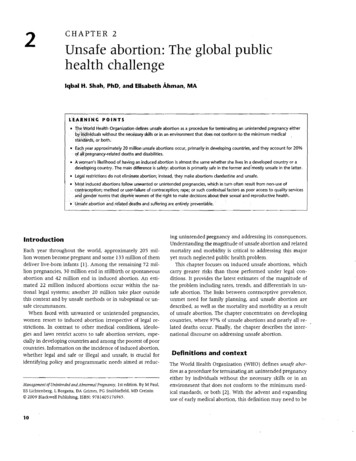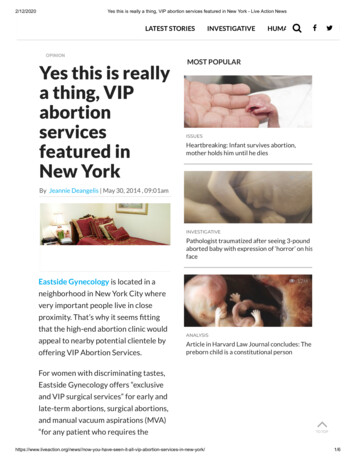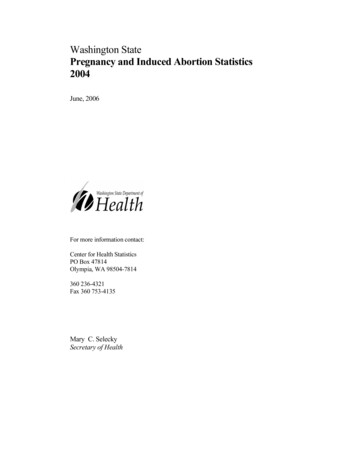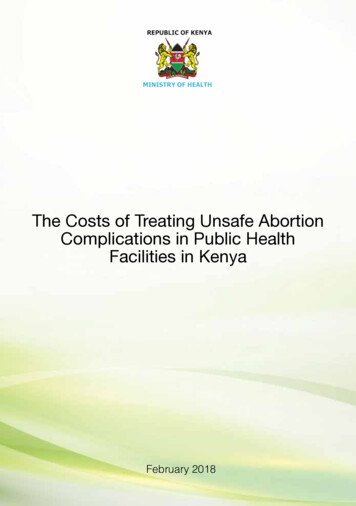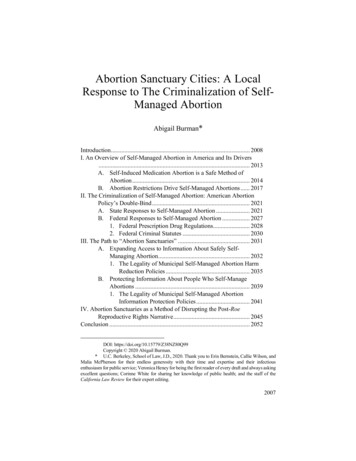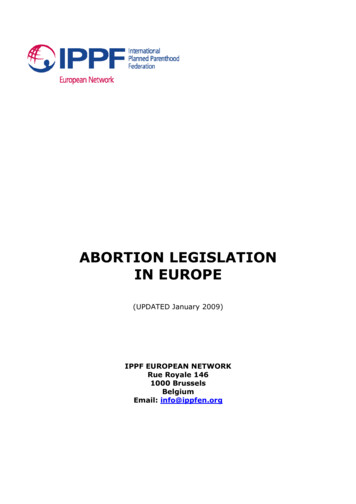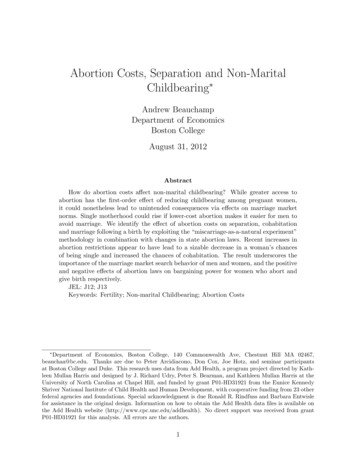
Transcription
Abortion Costs, Separation and Non-MaritalChildbearing Andrew BeauchampDepartment of EconomicsBoston CollegeAugust 31, 2012AbstractHow do abortion costs affect non-marital childbearing? While greater access toabortion has the first-order effect of reducing childbearing among pregnant women,it could nonetheless lead to unintended consequences via effects on marriage marketnorms. Single motherhood could rise if lower-cost abortion makes it easier for men toavoid marriage. We identify the effect of abortion costs on separation, cohabitationand marriage following a birth by exploiting the “miscarriage-as-a-natural experiment”methodology in combination with changes in state abortion laws. Recent increases inabortion restrictions appear to have lead to a sizable decrease in a woman’s chancesof being single and increased the chances of cohabitation. The result underscores theimportance of the marriage market search behavior of men and women, and the positiveand negative effects of abortion laws on bargaining power for women who abort andgive birth respectively.JEL: J12; J13Keywords: Fertility; Non-marital Childbearing; Abortion Costs Department of Economics, Boston College, 140 Commonwealth Ave, Chestnut Hill MA 02467,beauchaa@bc.edu. Thanks are due to Peter Arcidiacono, Don Cox, Joe Hotz, and seminar participantsat Boston College and Duke. This research uses data from Add Health, a program project directed by Kathleen Mullan Harris and designed by J. Richard Udry, Peter S. Bearman, and Kathleen Mullan Harris at theUniversity of North Carolina at Chapel Hill, and funded by grant P01-HD31921 from the Eunice KennedyShriver National Institute of Child Health and Human Development, with cooperative funding from 23 otherfederal agencies and foundations. Special acknowledgment is due Ronald R. Rindfuss and Barbara Entwislefor assistance in the original design. Information on how to obtain the Add Health data files is available onthe Add Health website (http://www.cpc.unc.edu/addhealth). No direct support was received from grantP01-HD31921 for this analysis. All errors are the authors.1
How do abortion costs affect non-marital childbearing? Following Roe vs. Wade in1973, both non-marital childbearing and abortion incidence increased significantly in theUnite States. The theory of Akerlof, Yellen and Katz (1996) reconciles these seeminglyparadoxical trends by introducing externalities in the marriage market. If lower abortioncosts place the onus of the childbearing decision on the woman, thereby making it easierfor men to leave their partners, a pregnant woman (who does not avail herself of the lowercost abortion) may instead become a single mother. At issue is whether couples’ decisionto continue their relationships following a non-marital birth is influenced by abortion costs.This implication of integrating strategic search behavior into a dynamic marriage marketmodel has yet to be tested.1 Beyond the social sciences, the question of whether abortionlaws generate externalities is important for policy makers in light of the large number ofchildren in single-parent households and the dramatic recent changes in cohabitation andmarriage patterns in the modern marriage market.The existing literature on abortion laws has focused on first order effects: we know thatthe demand for abortions responds to incentives, leaving open the possibility for consequencesbeyond these first-order effects.2 More nuanced effects, like those involving male behavior,have been confined to the theoretical realm. Indeed, to support their theory Akerlof, Yellenand Katz (1996) look only at time-series data and descriptive statistics thus failing to grapplewith the many unobservables that could be simultaneously driving both abortion accessand non-marital childbearing. Formally we cannot test a theory of the post-legalizationdiminution of norms because we are unlikely to observe as large a cost change as legalizationagain in the U.S. However, we can test for whether current norms governing relationship1Important contributions have been made integrating a search framework with cohabitation by Brien,Lillard and Stern (2006), and in examining partner substitution in a discrete choice setting by Choo andSiow (2006).2Haas-Wilsom (1996), Levine, Trainor and Zimmerman (1996), Blank, George and London (1996), Bitlerand Zavodny (2001), and Levine (2003) all measure the impact of state-level laws on abortion, birth andsexual behavior, but not marriage. Findings tend to be consistent with economic theory: public fundingincreases abortion; restrictions such as parental consent reduce it. These laws are particularly relevantfor minors (Haas-Wilsom (1996), Girma and Paton (2011)). Girma and Paton (2011) exploits the timingof access to emergency birth control (EBC) in northern Britain and shows that increases in EBC lead toincreases in sexually transmitted infections, with mixed evidence about the effect on pregnancies.2
status following a birth responded to recent changes in access to abortion, allowing us tosay whether norms similar to those outlined in Akerlof, Yellen and Katz (1996) are stilloperative.The fundamental question we aim to answer is whether, conditional on pregnancy, womengiving birth in areas with lower abortion costs see a higher probability of dissolution with thebiological father? The comparison is two-fold: comparing women in low-cost areas versushigher cost areas and comparing those who give birth relative to those who do not givebirth. The focus is on the interaction between these two in order to determine if givingbirth and facing higher abortion costs interact to decrease the chances of dissolution. Toestimate this effect we must overcome at least two major sources of endogeneity: unobserveddifferences in the marriage market across areas with high and low costs, and choosing togive birth or not. Since, abortion access is not independent of marriage market conditions sowe exploit within-state variation over seven-year time period in public funding and parentalconsent laws to shift costs. Since the choice to give birth is conditional a partner’s interestin having a child, birth is endogenous with respect to relationship status. To deal with thiswe employ the recent econometric work of Ashcraft, Fernandez-Val and Lang (Forthcoming)which outlines the conditions under which we can use miscarriage as a natural experiment.3Our results imply that removing public funding actually decreased single motherhoodand increased cohabitation among poor and young women. Estimates show around a 13%lower chance of being single following a birth in a state where funding was removed. Thispolicy impact is substantial: if the entire sample were to experience a removal of abortionfunding, these estimates would imply that the probability of cohabiting or marrying amonglow-income mothers would increase by between 12 and 18 percentage points. Among childrenof low-income mothers, the fraction children living with both biological parents at the time3We mainly follow the insights of Hotz, McElroy and Sanders (2005) and Ashcraft, Fernandez-Val andLang (Forthcoming), who show that using OLS and IV estimators can deliver bounds on the effects of birthon labor market outcomes for conditionally random miscarriage. Akerlof, Yellen and Katz (1996) and Kaneand Staiger (1996) provide models of this information flow, which empirically leads to a simultaneity biaswhen we condition on birth.3
of birth would rise by rouhgly 10% percentage points.The estimates here suggest a key channel for understanding non-marital childbearingfirst outlined by Akerlof, Yellen and Katz (1996). Namely we find evidence that changes toabortion costs result in a spillover-effect on the relationship terms of women who give birth.This may represent differential sorting into relationships where births occur, or improvedbargaining power within the relationship. Either way the pattern of results highlights thematching behavior of fathers, either before or after a non-marital birth. It seems plausiblethat for the couples we examine cohabitation is the relevant relationship being bargainedover.4 While we have little to add to a debate over abortion rights per se, it appears thatabortion laws have consequences along the broader sequence of choices leading to singlemotherhood, with negative consequences for women who decide to give birth. As a first steptoward understanding how the costs of abortion and relationship terms interact, we reviewthe relevant theoretical work on non-marital childbearing.1Abortion Costs and Non-marital ChildbearingTwo theoretical contributions to non-marital childbearing and abortion costs guide the discussion here. Both examine how a reduction in the cost of abortion changes decisions madeby men versus women, ultimately leading to different predictions about the effects on nonmarital childbearing. The Kane and Staiger (1996) model captures the insurance value ofabortion. Price changes of differing magnitudes can generate different channels for access toreduce non-marital childbearing. In contrast, Akerlof, Yellen and Katz (1996) model a decrease in “shotgun” marriages following abortion cost declines, which reduces the incentivesfor male commitment.54In our sample marriage rates are relatively low given the age distribution, nonetheless we still see roughlyone-third of these young women marry the biological father following a birth.5Both models treat marriage as a commitment to maintain the relationship with the partner, presumablyforgoing other relationships. In this sense we expect the predictions below to hold for cohabitation as wellas marriage.4
Kane and Staiger (1996) model information revealed between pregnancy and resolution,interpreted as whether or not the birth would be “legitimated” (i.e. followed by marriage).For women who prefer to remain childless unless married, access to abortion insures againstsingle motherhood. In the model, small decreases in abortion costs are decreases in the priceof insurance among the insured. As insurance costs fall, increased risky behavior increasespregnancies. Some pregnancies end in abortion, and others end in in-wedlock births. Nonmarital births are perfectly avoided because of abortion services. For large decreases inabortion costs, the channels are different. Large changes can only occur if moving from higherabsolute cost levels (like the pre-Roe vs. Wade U.S.). With prohibitively high abortion costs,some women would have been forced to have a child out of wedlock. With lower costs, theycan now afford to exercise the insurance option of abortion. This change shifts births fromoutside to within marriage. The first two rows of Table 1 illustrate the effects of small versuslarge decreases in abortion costs.In Akerlof, Yellen and Katz (1996) when abortion costs fall, women willing to use abortionare willing to have sex without a pre-commitment.6 If this fraction of “abortion-using”women is high enough, women who will not use abortion drop their pre-commitment demandsas well. This is because the two groups are competing in the marriage market for men who donot want children. Men have better outside options when abortion costs fall, so women whowant children lose the bargaining power to insist on a relationship following a pregnancy.The effects are listed in Row 3 of Table 1, where the relevant difference from the insurancemodel is the increase in the fraction of non-marital births.7 In Row 3 those who would havemarried can now abort, lowering marital childbearing and births, and increasing abortion.6Before abortion was available, a pre-commitment to marriage was the norm for dealing with non-maritalpregnancies.7A second model generates similar implications from different assumptions. Men value their partnersaltruistically, but lower-cost abortions reveal that those who fail to obtain abortions have a lower disutilityof being a single parent than those who obtain abortions. The drop in abortion costs lowers the meandisutility of single mothers. A man’s probability of marriage is an increasing function of this mean disutility,since he cannot believe revelations by his partner about her disutility. As costs fall, so does the disutility ofsingle mothers and the likelihood of marriage.5
Those who do not abort see a higher chance of separation, raising non-marital childbearing.8This higher chance of separation is one prediction we test for below.Both modeling approaches omit something: Kane and Staiger (1996) do not allow strategic choices by men to vary systematically with abortion costs, while Akerlof, Yellen and Katz(1996)ignore the insurance value of abortion. Akerlof, Yellen and Katz (1996) predicts highernon-marital childbearing following abortion cost declines because of the increased likelihoodof separation, while Kane and Staiger (1996) predicts decreases in non-marital childbearingand no increases in separation among those who give birth. The magnitude of cost changescan vary substantially with individual characteristics (e.g. being on Medicaid or a minor instates with restrictive laws), so all of these incentives (large and small) may be operatingsimultaneously. This suggests that given the ambiguous theoretical predictions, establishingwhich incentives dominate is an empirical question which we now turn toward answering.2Empirical StrategyOur goal is to estimate the effect of giving birth on separation, and in particular the effect ofgiving birth in places where abortion costs have increased. The baseline estimation equationtakes the following form:Separationi (γb0 Pi γb1 AGi γb2 AGi · Pi γb3 )0 Bi Xi0 γx λ(Zi0 δ) εi .(1)where Bi is birth, Pi is the policy change restricting access to abortion (e.g. removal offunding or imposition of parental consent), AGi is an indicator for being in the affectedgroup (e.g. poor or a minor), and their interaction captures the change in separation amongthose who give birth when abortion costs are rising. Here Xi are other controls which can8In addition to altering outcomes for those having sex, the models of Akerlof, Yellen and Katz (1996)generate incentives for some women to stop and start having sex. Some women will no longer risk becomingsingle mothers, decreasing non-marital births. Others engage in sex as they can now afford an abortion inthe event of a pregnancy, with no effect on non-marital births.6
include individual, partner, community, attributes and state fixed-effects, along with thelevel effects of the policy and affected group indicators.The first step in obtaining credible estimates of γb is to exploit policy changes influencingthe respondents in Add Health, inducing policy variation in Pi . Here we use whether thestate of residence changed legal regimes between Wave I (1995) and Wave III (2001). We alsoinclude Wave I state level fixed effects and pregnancy year fixed effects, to ensure variationin Pi comes from changes within-states over time. The second step is to deal with theendogeneity of Bi , for which we use an IV-strategy outlined in Ashcraft, Fernandez-Val andLang (Forthcoming).Ashcraft, Fernandez-Val and Lang (Forthcoming) show that one can estimate the causaleffect of giving birth on outcomes for pregnant women who would not choose to abort.When outcomes are mean independent with respect to the timing of abortion, the consistentestimator is a linear combination of OLS-estimates on only those who give girth or miscarryand the IV-estimates on the entire sample. For this approach to be valid we need to assumemiscarriage is conditionally random.9As Ashcraft, Fernandez-Val and Lang (Forthcoming) show, the major problem using miscarriage is that abortion and miscarriage are competing risks. Assume for the moment thatall abortions precede all miscarriages and births (and label this Assumption I). In such aworld, miscarriages represent a conditionally random set of women who wanted to give birth.Comparing outcomes between births and miscarriages will identify the effect of birth on outcomes, and OLS is sufficient to pick up the effect since treatment is conditionally-randomand not selected through abortion choices. Now suppose the opposite: all miscarriages precede all abortions (we label this Assumption II). In this world miscarriages are a randomsample of women, a fraction of whom pB wanted to give birth, and 1 pB wanted to have9Conditional refers to a set of behaviors in pregnancy we observe in the data, namely smoking anddrinking. Hotz, Mullin and Sanders (1997) allow for bounds on the effect of birth on outcomes when somemiscarriages are non-random. We have estimated these bounds and the relevant (upper) bounds have thesame sign as the results presented below.7
an abortion.10 Under Assumption II, instrumenting for birth with miscarriage delivers theimpact of treatment, assuming that abortion and miscarriage have the same effect on outcomes.11 Ashcraft, Fernandez-Val and Lang (Forthcoming) show the true effect is a convexcombination of the OLS and IV estimates if the outcomes (here separation) is conditionallymean independent with respect to the timing of abortion. For our goal of signing the effectit is sufficient to (1) test for this mean independence, and if it holds (2) estimate the OLSand IV models.12If the assumptions outlined are maintained, we formulate a system of equations to beestimated by instrumental variables. Here we have the following first-stage:Birthi (ρ0b1 Pi ρ1b1 AGi ρ2b1 AGi · Pi ρ3b1 )Mi Xi0 ρx1 ηi1Birthi · Pi (ρ0b2 Pi ρ1b2 AGi ρ2b2 AGi · Pi ρ3b2 )Mi Xi0 ρx2 ηi2Birthi · AGi (ρ0b3 Pi ρ1b3 AGi ρ2b3 AGi ·Pi ρ3b3 )Mi Xi0 ρx3(3) ηi3Birthi · Pi · AGi (ρ0b4 Pi ρ1b4 AGi ρ2b4 AGi · Pi ρ3b4 )Mi Xi0 ρx4 ηi4where Mi is an indicator of miscarriage. The first equation corresponds to instrumentingfor birth with miscarriage, the subsequent equations instrument for the interaction of birthwith the policy indicator, affected group indicator, and their interaction respectively, usingmiscarriage and its corresponding interactions.10This is the assumption put forth in Hotz, McElroy and Sanders (2005).Since we are interested in separation, we only use miscarriages prior to twenty weeks of gestation inthe empirical section. Results were largely insensitive to this cut-off. ? show a substantially higher risk ofseparation following a stillbirth (greater than 20 weeks gestation) than a miscarriage.12OLS and IV estimates are sufficient to sign the effect since the average treatment effect takes the followingform:11AT E (αρOLS (1 α)βρIV )/(α (1 α)β).(2)To calculate (α, β) requires more moments namely, (1) the fraction of women who would give birth if theydid not miscarry, a “latent-birth” type (2) the fraction of women who would have a miscarried had theynot aborted, a “latent-miscarriage” type (3) the fraction of women not giving birth (who either miscarry orabort) who abort. Since all three moments are (positive) probabilities, the true ATE must lie between ρOLSand ρIV .8
3DataWe use the National Longitudinal Study of Adolescent Health (Add Health), which beginsurveying a large sample of teens aged 12-18 in 1995, with follow-ups in 1996, 2002 and2008.13 The data used here come from a retrospective history of all relationships between1995-2001 obtained at Wave III. Partner characteristics were recorded for each relationship,and a detailed survey given about each pregnancy that occurred with that partner.3.1Estimation SampleWe first focus on unmarried women experiencing a first pregnancy. The sample restrictionsare given as follows: beginning from a sample from female-reported first pregnancies (2728),less married at conception (2389), less stillbirths (2163).14 Missing probability weights andgeographic identifiers, and non-response further limit the final sample size to (1859) pregnancies.15Table 2 gives summary statistics for two samples. The first is consistent with Assumption(I) above, and so includes only those miscarrying or giving birth. The second sample isconsistent with Assumption (II), and includes births, abortions and miscarriages. We nowoutline a number of features of these data. The second sample we can examine abortionreporting. To check for reporting problems, Table 2 allows one to compute the abortionratio (abortions per 1000 live births) for the estimation sample. In Table 2 the abortionratio is 309, comparable to age specific administrative data from Centers for Disease Control(CDC (2003)), which show an age-specific abortion ratio for 15 to 24 year-olds of 330.5.1613The design was a stratified random sample of U.S. high schools and associated middle schools; Wave Iwas conducted between 1994 and 1995, Wave II in 1995-1996, Wave III in 2000 and 2001 and Wave IV in2007.14Stillbirths have been documented to have larger influence on a couples’ likelihood of separation. SeeGold, Sen and Hayward (2010).15Wherever possible, indicators were included for non-response regarding partner characteristics, whichmay be particularly relevant. Most non-response problems come from linking the 2001 relationship rosterdata with early adolescent data on puberty, and from smoking or drinking during pregnancy questions, whichis of much less concern than if non-response were related to relationship characteristics. Probability weightsare used to correct for unrepresentative over samples in the Add Health survey design.16CDC data are drawn from 2000 and age-specific rates come only from 46 reporting areas in the U.S.9
Finer and Henshaw (2006) use data from the Alan Guttmacher Institute, which maintainsmore accurate data than CDC. From their Table I, the 2001 age-specific ratio of abortionto pregnancies (including fetal losses) is 264.31. This sample has a ratio of 227. Theseestimates suggest the Add Health data capture between 86 and 93% of abortions that likelyoccurred to women in our sample, given that we employ probability weights from Wave III tocorrect for minority over sampling.17 The percentage of pregnancies ending in miscarriagesis similar to other data sources like the NLSY79 and the National Survey of Family Growth:12%-14%.18 While less than ideal, these reporting percentages are far better than those fromother longitudinal data sources.19In the upper panel of Table 2 separation, marriage and cohabitation are also listed. Separation is measured one year following conception, marriage and cohabitation are indicatorsfor whether either occurred during the relationship.20 Marriage and cohabitation are lessfrequent, and separation more frequent, when we include women obtaining an abortion.Around 5% and 1% respectively experienced a change in their state abortion laws between1995 and 2002. The data show that 2 states in the sample removed abortion funding. Thepolicy changes from for parental consent appear to be the result of migration. For thesepolicy changes to be endogenous would require that minors’ parents moving is influenced bytheir children’s relationship and pregnancy outcomes, which seems unlikely. However, givenhow few individuals experienced a parental-consent change and that it may be related tomoving, we view these as a check on the funding results whose variation is driven by moreCalculations come from Table 4 of the CDC report. The age of the Add Health Sample is roughly half 15-19and half 20-24 in the pregnancy year. 75% of pregnancies happened in 1997-2001.17We note that the surveys selection mechanism likely generates a sample which is not nationally representative of women obtaining abortions.18The National Survey of Family Growth is one of the few reliable sources for miscarriage estimates. Thetotal miscarriage rate rose slightly through the 1980s and early 1990s. Ventura, Taffel, Mosher, Wilson andHenshaw (1995) attribute this to an aging population. For the age group here they show 12-14% as well. TheAdd Health data still suffer from underreporting problems, but do have better reporting than the NLSY79.19Lundberg and Plotnick (1995) document severe reporting problems in the NLSY79, which sees reportingrates around 60% for whites, and even lower for minorities.20Separation results were nearly identical when using 9-24 months as cutoffs. Respondents were asked tocombine all periods of on-again off-again sexual intercourse with the partner so that separation measures theend of all sexual contact between the (former) partners.10
plausibly exogenous legal changes within each state over-time.21 In the lower panel we seefor both samples that partner characteristics include the standard two-year age gap betweenmale and female partners. Although our sample is young, they are not solely women experiencing a teen pregnancy, a point underscored by the fact that roughly one-third marrythe biological father following a non-marital birth. The partners of women who experienceda non-marital-first pregnancy, are more frequently minority men. Finally, the educationalattainment at the time of pregnancy is concentrated at or below twelve years of schooling.3.2State-Level Policy Changes and Policy EffectsThe Add Health data contain observations on state-level funding, parental consent, andwaiting period laws in both 1995 and 2002. We cannot pin down the exact time of policyenactment because we do not observe the state where the pregnancy occurred. We can,however, identify whether the state of residence had different policies in 1995 and 2002. Asmall amount of the variation in policies evident in Table 2 results from individuals’ movingstates.22 Given that state funding and parental consent laws have been shown to inducesizable cost changes for the affected demographic groups, we focus on those who were minorsat the time the sexual relationship started, and those with a Wave I family income belowthe median.23The effects of removing public funding and imposing parental consent laws on the likelihood of separation one year following the pregnancy are presented in Table 3. The estimates,from a linear probability model, show dramatic differences in the likelihood of separationamong women giving who experienced a binding increase in abortion costs, with the likeli21Due to the Add Health data security requirements we do not know state identifiers, and cannot linkstate identifiers across waves. Policy and moving information are both drawn from questions specificallyasked to individuals in each cross-section.22Only 9% of the pregnant sample moved to another state between Wave I and Wave III. Controlling formoving-state indicator had no effect on the policy impacts estimated below. Dropping movers and examiningonly public funding showed very similar results.23Results below strengthen when the income threshold is reduced, and the median is admittedly arbitrary.See Medoff (2007) for a review of how these restrictions reduced abortion demand.11
hood of separation falling.24 Importantly no significant effects show up for those who shouldnot have been affected by the policies. These results persist when including state and yearfixed effects, along with a large set of individual control variables outlined below.The lower panel of Table 3 presents LPM estimates for giving birth among all pregnancies (those who gave birth, aborted, or miscarried). These estimates also so large policychange effects on the likelihood of birth, though sign for removing public fundings is counterintuitive. These estimates suggest that removing public funding actually reduced the likelihood of birth among the low income group. This is the same result which Kane and Staiger(1996) obtained, which they argued was consistent with an endogenous pregnancy model.For the imposition of parental consent laws, we see an increase in the probability of birthamong minors, which is also consistent with the prior literature (see Haas-Wilsom (1996)).The results point toward two facts: the policies did influence pregnancy outcomes, and alsoappeared to influence dissolution, although we cannot separate selection into pregnancy orbirth from bargaining effects conditional on pregnancy or birth. While these estimates aresuggestive evidence that abortion costs change the underlying household bargaining process,they suffer from the fact that birth is not an exogenous conditioning variable. We now turnto using miscarriage to deal with this problem.3.3Validity of MiscarriageTable 4 divides the timing of abortion decisions into four categories and tests for differencesin mean separation rates. While the fraction of couples separating increases slightly withthe length of the pregnancy, we cannot reject the null of mean independence across groups.Additionally the t-statistic from a linear regression of length of pregnancy on separation wasalso well below one both with and without controls.25 . We view this as evidence that thestrategy outlined by Ashcraft, Fernandez-Val and Lang (Forthcoming) for identifying the24Estimates of the policies’ association with birth, available upon request from the author, looked similarthose from Kane and Staiger (1996), with increase in abortion costs reducing the probability of births.25Using different lengths of time following pregnancy we were unable to reject the null of mean independence12
effect of birth on outcomes under mean independence is a reasonable way forward.Table 5 shows conditional means for the two estimation samples by the pregnancy outcomes. Under Assumption (I), miscarriages and births show no significant differences formany characteristics with the exception of drinking and smoking during pregnancy, andtest scores and maternal education. Under Assumption (II), where we include births andabortions in the non-miscarriage group, these differences disappear except fir smoking (anddrinking is still significant at the 10% level). This suggests that the miscarriage group is asample mixing some women who would have given birth, and some who would have aborted,had they not miscarried. If this is t
Both examine how a reduction in the cost of abortion changes decisions made by men versus women, ultimately leading to di erent predictions about the e ects on non-marital childbearing. The Kane and Staiger (1996) model captures the insurance value of abortion. Price changes of di ering magnitudes can generate di erent channels for access to
